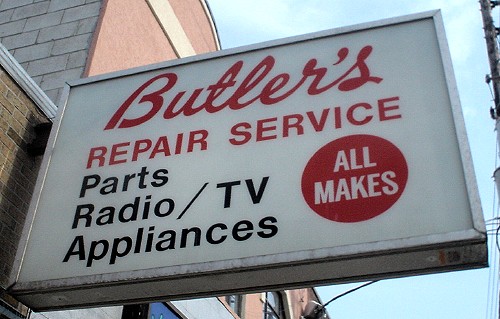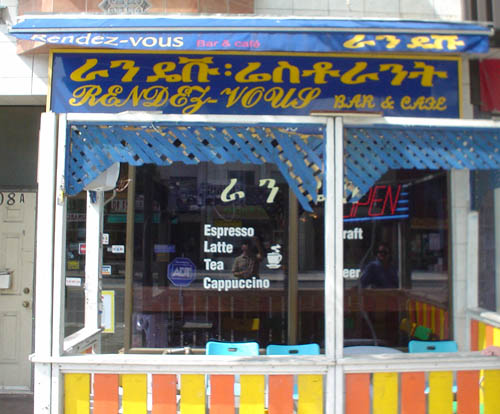
Butler’s Week (1)

The foregoing posting appeared on Joe Clark’s personal Weblog on 2006.08.23 16:54. This presentation was designed for printing and omits components that make sense only onscreen. The permanent link is: https://blog.fawny.org/2006/08/23/butlers1/
Organizing our marvellous neighbours
Another in a series of postings on CBC captioning (also see the separate page on the topic)
We return now to our ongoing consideration of the exact ways in which CBC is screwing up its captioning. (There’s a whole list, which explains the numerous and ongoing postings.) Today it’s something so basic we shouldn’t even have to talk about it: Spelling.
Did you know the Canadian Broadcasting Corporation uses British spellings in the captioning it creates? Well, it does: -ize words become -ise words and -our remains -our. I am not sure how the echt-Canadian concept of snow tires would be rendered. Snow tyres doesn’t make all that much sense, does it? But nothing here does.
I don’t know how to explain this to people who are so resistant to reality, but there actually is such a thing as Canadian spelling and it is, in fact, different from U.S. and U.K. spelling in that it combines elements of both. [continue with: Organizing our marvellous neighbours →]
The foregoing posting appeared on Joe Clark’s personal Weblog on 2006.08.22 14:35. This presentation was designed for printing and omits components that make sense only onscreen. The permanent link is: https://blog.fawny.org/2006/08/22/ise-ll-our/
Ethiopic rendez-vous

The foregoing posting appeared on Joe Clark’s personal Weblog on 2006.08.21 14:34. This presentation was designed for printing and omits components that make sense only onscreen. The permanent link is: https://blog.fawny.org/2006/08/21/ethiopic-script/
’Tis an error i’faith
Another in a series of postings on CBC captioning (also see the separate page on the topic)
It is of course tempting to descend into pedantry when discussing the seemingly arcane field of captioning. (How arcane can it really be when it’s on nearly every program and millions of people watch it?) It is all the more tempting when discussing CBC captioning.
So let’s go hog-wild! What is with some CBC captioners and their irrational fondness for single quotation marks?

It’s a British perversion<slash>anachronism and a consequence of the CBC captioning department’s refusal (a) to accept the reality of Canadian orthography and (b) to break from a colonial past. I’ll have more on that in a future posting. But for now, it is indisputable that Canadian orthography uses double quotes in first instance (single then double then single then double when nested), with commas and periods inside quotation marks in every ordinary case. (Exceptions are so rare they are almost never found on TV, and they include listings of computer code – alt="CBC captioning fuckups", for example, is correct – and literal renderings of quotation-mark rules themselves.)
There are other downsides to using single quotes.
-
Due to shitty implementation by unilingual, typographically-ignorant American engineers, we’ve only had neutral quotes to play with. Yes, real quotation marks are now part of the extended character set, but nobody uses them. While the apostrophe character is nominally a neutral quote, early decoder designs rendered it as a closing quotation mark or apostrophe because single quotation marks were scarcely ever used. (NCI flatly refused to use them, actually italicizing quotes within quotes.) These neutral quotes, then, used curled-quote or apostrophe glyphs. Hence if you start a word with this character, it looks like an apostrophe much of the time. This will depend on font, and I most Line 21 caption fonts I’ve seen do it this way even today.
-
CBC, like many users of Swift, the fantastically expensive captioning software (up to US$12,000 a seat!), has some kind of encoding error that causes doubling back, deletion, and reinsertion of a character whenever apostrophe is transmitted. I assume this is due to having smart quotes (sic – a misnomer in every case I know of) turned on in whatever tool they write in.
The software seems to be set to support the extended character set or part of it. According to Robson (The Closed Captioning Handbook, p. 312), if the open-single-quote character (code
12,26) is supported, then plain apostrophe (not ASCII39but27) “should be curled the other way so that it can be used as a closing single quote.” There is some kind of weird shit happening in Swift whereby apostrophe is saved as some other character (opening single quote?) then removed and re-rendered by backspacing. If that sounds like an oddball display phenomenon, it is, but it’s built into the later revisions of the Line 21 spec.I have alerted Softel, makers of Swift, of this bug and offered to send them tapes, but Softel has a habit of ignoring me even when I’m right, which is usually.
Oh, but I haven’t given you the punchline yet. Only some CBC captioners use single quotes, while others use double, and neither group is clear on whether Canadian or British rules apply for the placement of periods and commas.
Do you still harbour the hope that these people surely must know what they’re doing if they’re being paid $38K to caption highbrow shows for the public broadcaster?
The foregoing posting appeared on Joe Clark’s personal Weblog on 2006.08.21 13:54. This presentation was designed for printing and omits components that make sense only onscreen. The permanent link is: https://blog.fawny.org/2006/08/21/apostrophism/
Four orange pylons

The foregoing posting appeared on Joe Clark’s personal Weblog on 2006.08.20 13:49. This presentation was designed for printing and omits components that make sense only onscreen. The permanent link is: https://blog.fawny.org/2006/08/20/pylons/
Barbershop grotesk

The foregoing posting appeared on Joe Clark’s personal Weblog on 2006.08.17 17:31. This presentation was designed for printing and omits components that make sense only onscreen. The permanent link is: https://blog.fawny.org/2006/08/17/barber-grotesk/
1960s Convenience
I think this is a poorly-rendered variation of this groovy display-type form.

The foregoing posting appeared on Joe Clark’s personal Weblog on 2006.08.16 20:10. This presentation was designed for printing and omits components that make sense only onscreen. The permanent link is: https://blog.fawny.org/2006/08/16/convenience/
‘Sisters’
Edmund White, My Lives:
In those days, gay guys divided other gay men into three categories: forget-it; hot numbers; and sisters. A sister was a pal in whom there could never be any further sexual interest, even if the initial meeting had occurred through cruising. With a sister one let down one’s hair and relaxed. One no longer had to look good or appear desirable or (depending on the target audience) vaguely menacing. With a sister one could “dish,” that is, talk about real interests like dick size, one’s own humiliation in the bar last night, the fight to lose weight or the latest Streisand record. Presumably one was more honest with a “sister” than with a “husband,” though some gay men found campiness more a strain than dull normality. Sisterhood, after all, was a link to the queer past and required imagination and flair.
The foregoing posting appeared on Joe Clark’s personal Weblog on 2006.08.15 17:04. This presentation was designed for printing and omits components that make sense only onscreen. The permanent link is: https://blog.fawny.org/2006/08/15/sisters/
Joe did Iceland (2): Keflavik
Keflavik Airport in Iceland is the most beautiful I’ve ever been in, even taking into account a few of its drab hallways. I’d never been in airport with angular walls finished in variegated stone tiles. I broadly approved of the signage, although it is unwise to use different colours for different languages. (Which is more important, the white Icelandic or the yellow English?)
They X-ray your hand luggage upon arrival, which is a bit odd. A Marianne Sägebrecht type, half a head taller than I, stood in front of me after I walked through the metal detector and muttered something in Icelandic. I removed my little toque and was waved on through. Had I passed for Icelandic? (Later that day, a late-20s IceWigger™ at a “convenient” store flatly refused to speak to me in English, which I thought was great.)
In the arrivals lounge stood my fellow invited speakers – Molly, Eric, Shaun Inman with missus, Malarkey, and Dave Shea. “Hello, Uncle Grumpy,” Eric said, presumably reacting to my smile. But where was our esteemed host, Einar Gústafsson?
I was halfway to schlepping over to a payphone (so very passé in a technological society like Iceland) when suddenly he appeared, the picture of health at 7:00 friggin A.M. Along with him were Hugi “Huggy Bear” Þorðarsson and Haukur Már, a name that, I assure you, is not pronounced the way you think. We bundled into various cars and by God I made sure to be in the front seat of Einar’s Rav4. Molly and Malarkey rode in the back. I got all seatbelt-Nazi on Malarkey’s arse, who really needs to improve his evolutionary survivability in this way.
It is trite to remark that a drive from the airport into Reykjavík approximates a rally over the lunar landscape. That would surely be true if the moon had an Alcan smelting plant, an American military base, and dozens of inukshuks by the side of the road. (Rather like the sahibs explaining the Indians to themselves, I had to explain that the little figures made from piled-up stones were similar to inukshuks, Inuit land markers that often signified the location of a hunter’s first kill. Charming. But certainly Nordic.)
It is also trite to remark that, like San Francisco, if you don’t like the weather in Iceland it will change in five minutes. During our 40-minute drive, we enjoyed partly-cloudy sunshine, flat-out rain, hail, and snow. We arrived at the Nordica Hotel, where I was forbidden to check in until a certain time and where some kind of Muslim conference was underway. Thus began a small odyssey at this, the nicest hotel I have ever seen.
The foregoing posting appeared on Joe Clark’s personal Weblog on 2006.08.15 13:11. This presentation was designed for printing and omits components that make sense only onscreen. The permanent link is: https://blog.fawny.org/2006/08/15/joedidiceland2/